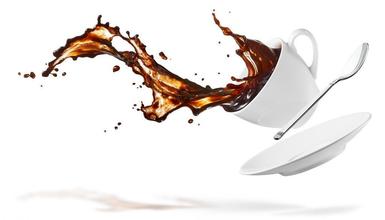Is it difficult to grow coffee trees? which places in China are the most suitable for growing coffee?
Coffee growing seedlings
1, the choice of nursery land close to the water source, convenient transportation, loose fertile soil, deep soil layer, good drainage loam or sandy loam, PH 6 - 6.5 paddy field or early nursery land, and close to the coffee garden. Turn the ground 0.20 - 0. 30 meters, ridge width 1.0 - 1. 2 meters, about 10 meters long, and apply decomposed farm manure on the soil moisture, 3000 kg per mu, mix the soil and fertilizer evenly as nutrient soil for bagging, nutrient bag specification is 0.15× 0.20 meters, put nutrient soil into bags, 12 bags in each row are neatly placed, upright, 60 - 70,000 plants can be placed per mu, shade branches are planted according to the pile spacing of 4 meters, height 2. 0 meters shade density 75 - 85%, surrounded by fences to protect shade, nursery will be built.
2, germination bed finishing and sowing will have been hoe fine, fertilizer nursery by spacing 0. 50 meters, width 1. 20 meters, height 0.15 - 0. 20m ridge soil spreading, soil disinfection with carbendazim, adding 0.05 - 0.10m thick river sand can be, Fu dam planting 7963 new varieties, about 5000 seeds per kilogram, soaking in warm water at 40 - 45℃ for 2 - 3 minutes, then soaking in clean water for 24 hours, taking out seeds evenly sown on the sand bed, to avoid accumulation is appropriate, sowing rate is 0.50 - 0.60kg/square meter, pressing into the sand with wood, Covers 0.01 - 0. 02 meters of river sand, then covered with straw on the surface, poured through water. 80 days after sowing, the seeds will be unearthed. Water regularly before they are unearthed to prevent drought. Remove the weeds in time after the seedlings are unearthed.
Coffee, as an elegant, fashionable and high-grade beverage, has long been popular all over the world, and has been listed as the first of the world's three major beverages (coffee, tea and cocoa). Coffee cultivation has also spread to 76 countries and regions all over the world. In 1983-1984 alone, the world's coffee production reached 5.5 million tons, and the export volume was 4.2 million tons. Among them, Brazil, known as the "Coffee Kingdom", has the largest output and export volume. However, the hometown of coffee is not Brazil, but Ethiopia in Africa. Up to now, there are large wild coffee forests in the dense jungle of Kafa Province in the southwest of the country. The word "coffee" comes from the place name "Kafa".
Coffee grows mostly in the fertile land between the Tropic of Cancer and the Tropic of Capricorn, where the fruit ripens. Not all of the land in this area can produce good coffee trees. The ideal planting conditions for coffee trees are: a warm climate with a temperature between 15 ° C and 25 ° C, and rainfall throughout the year must reach 1500 mm to 2000 mm, and its rainfall time should match the flowering cycle of coffee trees. Of course, in addition to seasonal and rainfall coordination, there must be fertile soil. The soil most suitable for coffee cultivation is fertile, well drained soil containing pozzolanic matter. In addition, although sunlight is an indispensable element for coffee growth and fruit, too strong sunlight will ruin the growth of coffee trees, so each producing area usually cooperates with planting some shade trees, generally planting bananas, mangoes and legumes and other tall trees. The ideal altitude is 500 to 2000 meters. Therefore, Jamaica Blue Mountain coffee grown at an altitude of 800 meters to 1200 meters has the best quality. It can be seen from this that the conditions for cultivating high-quality coffee are quite strict: sunlight, rainfall, soil, temperature, and the way coffee beans are harvested and produced will affect the quality of coffee itself.

Important Notice :
前街咖啡 FrontStreet Coffee has moved to new addredd:
FrontStreet Coffee Address: 315,Donghua East Road,GuangZhou
Tel:020 38364473
- Prev

Introduction to the difference between American Coffee Taste and Italian style
Simple American coffee is divided into two categories: the east coast of the United States is stronger than the west coast, and the south is stronger than the north. Ethnically speaking, immigrants from southern Europe and Latinos prefer strong coffee to those from Britain, Germany and northern Europe. Americans are dismissive of all kinds of exquisite coffee made by Europeans. Americans drink coffee freely, and coffee goes deep into their lives. It is difficult to separate and influence it.
- Next

Why did Starbucks choose Arabica Coffee beans, Robusta
Basically, it can be said that the quality of the coffee beans determines the ceiling of a cup of coffee, and the barista determines the height at which the coffee beans can reach. The two most important factors that determine the quality of coffee beans are the origin of coffee beans and the roasting of coffee beans. For large chain coffee shops like Xingjia and C, 100% Arabica beans can still be guaranteed. But out of success,
Related
- Beginners will see the "Coffee pull flower" guide!
- What is the difference between ice blog purified milk and ordinary milk coffee?
- Why is the Philippines the largest producer of crops in Liberia?
- For coffee extraction, should the fine powder be retained?
- How does extracted espresso fill pressed powder? How much strength does it take to press the powder?
- How to make jasmine cold extract coffee? Is the jasmine + latte good?
- Will this little toy really make the coffee taste better? How does Lily Drip affect coffee extraction?
- Will the action of slapping the filter cup also affect coffee extraction?
- What's the difference between powder-to-water ratio and powder-to-liquid ratio?
- What is the Ethiopian local species? What does it have to do with Heirloom native species?

